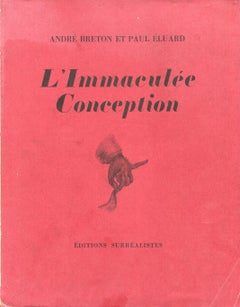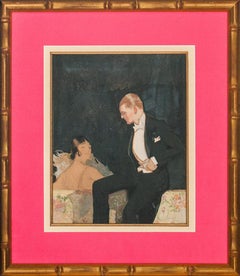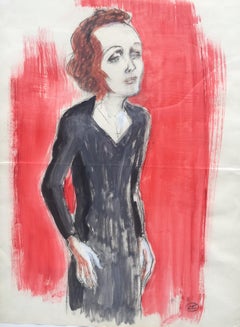1930s Art
Period: 1930s
Color: Pink
L'Immaculée Conception - Rare Book illustrated by André Breton - 1930
By André Breton
Located in Roma, IT
Edition of 2111 copies. Copy on Imponderable Sorel-Moussel paper. Original paperback cover. First edition. Beautiful copy of the relevant experimental work by Breton and Eluard. Very...
Category
Modern 1930s Art
Materials
Paper
Elegant Evening Attire c1930s Gouache & Watercolour
Located in Bristol, CT
Original c1930s illustration art depicting a dapper gent & fashionable lady in evening attire together w/ verso pencil head studies
Art Sz: 9"H x 7"W
Frame Sz: 15"H x 13"W
w/ gil...
Category
1930s Art
Materials
Watercolor, Gouache
Edith Piaf On Stage Watercolor signed Charles Kiffer circa 1935
Located in Paris, FR
Edith Piaf on stage watercolor and pencil on paper, mongrammed K for Charles Kiffer (1902-1992), Workshop stamp.
Charles Kiffer is well known for his figures, paintings, prints, pos...
Category
Modern 1930s Art
Materials
Watercolor
May All Of Your Shots Be Goals c1930s Drawn on Stone by Paul Desmond Brown (1893
Located in Bristol, CT
Signed LR, Drawn on stone, Ltd edition #4/100,
Two Polo Players Contesting
c1930s
Art Sz: 8"H x 12 1/2"W
Frame Sz: 13 1/2"H x 18"W
Hand-coloured charcoal drawing
Category
1930s Art
Materials
Charcoal
Related Items
"Lilian"
Located in Lambertville, NJ
Jim’s of Lambertville is proud to offer this artwork by:
Gershon Benjamin (1899-1985)
An American Modernist of portraits, landscapes, still lives, and the urban scene, Gershon Benj...
Category
Modern 1930s Art
Materials
Watercolor
The Abduction of the Sabine Women , a Renaissance drawing by Biagio Pupini
Located in PARIS, FR
This vigorous drawing has long been attributed to Polidoro da Caravaggio: The Abduction of the Sabine Women is one of the scenes that Polidoro depicted between 1525 and 1527 on the façade of the Milesi Palazzo in Rome. However, the proximity to another drawing inspired by this same façade, kept at the Ecole des Beaux-Arts, and to other drawings inspired by Polidoro kept at the Musée du Louvre, leads us to propose an attribution to Biagio Pupini, a Bolognese artist whose life remains barely known, despite the abundant number of drawings attributed to him.
1. Biagio Pupini, a Bolognese artist in the light of the Roman Renaissance
The early life of Biagio Pupini, an important figure of the first half of the Cinquecento in Bologna - Vasari mentions him several times - is still poorly known. Neither his date of birth (probably around 1490-1495) nor his training are known. He is said to have been a pupil of Francesco Francia (1450 - 1517) and his name appears for the first time in 1511 in a contract with the painter Bagnacavallo (c. 1484 - 1542) for the frescoes of a church in Faenza. He then collaborated with Girolamo da Carpi, at San Michele in Bosco and at the villa of Belriguardo.
He must have gone to Rome for the first time with Bagnacavallo between 1511 and 1519. There he discovered the art of Raphael, with whom he might have worked, and that of Polidoro da Caravaggio. This first visit, and those that followed, were the occasion for an intense study of ancient and modern art, as illustrated by his abundant graphic production.
Polidoro da Caravaggio had a particular influence on the technique adopted by Pupini. Executed on coloured paper, his drawings generally combine pen, brown ink and wash with abundant highlights of white gouache, as in the drawing presented here.
2. The Abduction of the Sabine Women
Our drawing is an adaptation of a fresco painted between 1525 and 1527 by Polidoro da Caravaggio on the façade of the Milesi Palace in Rome. These painted façades were very famous from the moment they were painted and inspired many artists during their stay in Rome. These frescoes are now very deteriorated and difficult to see, as the palace is in a rather narrow street.
The episode of the abduction of the Sabine women (which appears in the centre of the photo above) is a historical theme that goes back to the origins of Rome and is recounted both by Titus Livius (Ab Urbe condita I,13), by Ovid (Fasti III, 199-228) and by Plutarch (II, Romulus 14-19). After killing his twin brother Romus, Romulus populates the city of Rome by opening it up to refugees and brigands and finds himself with an excess of men. Because of their reputation, none of the inhabitants of the neighbouring cities want to give them their daughters in marriage. The Romans then decide to invite their Sabine neighbours to a great feast during which they slaughter the Sabines and kidnap their daughters.
The engraving made by Giovanni Battista Gallestruzzi (1618 - 1677) around 1656-1658 gives us a good understanding of the Polidoro fresco, allowing us to see how Biagio Pupini reworked the scene to extract this dynamic group.
With a remarkable economy of means, Biagio Pupini takes over the left-hand side of the fresco and depicts in a very dense space two main groups, each consisting of a Roman and a Sabine, completed by a group of three soldiers in the background (which seems to differ quite significantly from Polidoro's composition).
The balance of the drawing is based on a very strongly structured composition. The drawing is organised around a median vertical axis, which runs along both the elbow of the kidnapped Sabine on the left and the foot of her captor, and the two main diagonals, reinforced by four secondary diagonals. This diamond-shaped structure creates an extremely dynamic space, in which centripetal movements (the legs of the Sabine on the right, the arm of the soldier on the back at the top right) and centrifugal movements (the arm of the kidnapper on the left and the legs of the Sabine he is carrying away, the arm of the Sabine on the right) oppose each other, giving the drawing the appearance of a whirlpool around a central point of support situated slightly to the left of the navel of the kidnapper on the right.
3. Polidoro da Caravaggio, and the decorations of Roman palaces
Polidoro da Caravaggio was a paradoxical artist who entered Raphael's (1483 - 1520) workshop at a very young age, when he oversaw the Lodges in the Vatican. Most of his Roman work, which was the peak of his career, has disappeared, as he specialised in facade painting, and yet these paintings, which are eminently visible in urban spaces, have influenced generations of artists who copied them abundantly during their visits to Rome.
Polidoro Caldara was born in Caravaggio around 1495-1500 (the birthplace of Michelangelo Merisi, known as Caravaggio, who was born there in 1571), some forty kilometres east of Milan. According to Vasari, he arrived as a mason on the Vatican's construction site and joined Raphael's workshop around 1517 (at the age of eighteen according to Vasari). This integration would have allowed Polidoro to work not only on the frescoes of the Lodges, but also on some of the frescoes of the Chambers, as well as on the flat of Cardinal Bibiena in the Vatican.
After Raphael's death in 1520, Polidoro worked first with Perin del Vaga before joining forces with Maturino of Florence (1490 - 1528), whom he had also known in Raphael's workshop. Together they specialised in the painting of palace façades. They were to produce some forty façades decorated with grisaille paintings imitating antique bas-reliefs.
The Sack of Rome in 1527, during which his friend Maturino was killed, led Polidoro to flee first to Naples (where he had already stayed in 1523), then to Messina. It was while he was preparing his return to the peninsula that he was murdered by one of his assistants, Tonno Calabrese, in 1543.
In his Vite, Vasari celebrated Polidoro as the greatest façade decorator of his time, noting that "there is no flat, palace, garden or villa in Rome that does not contain a work by Polidoro". Polidoro's facade decorations, most of which have disappeared as they were displayed in the open air, constitute the most important lost chapter of Roman art of the Cinquecento. The few surviving drawings of the painter can, however, give an idea of the original appearance of his murals and show that he was an artist of remarkable and highly original genius.
4. The façade of the Milesi Palace
Giovanni Antonio Milesi, who commissioned this palace, located not far from the Tiber, north of Piazza Navona, was a native of the Bergamo area, like Polidoro, with whom he maintained close friendly ties. Executed in the last years before the Sack of Rome, around 1526-1527, the decoration of Palazzo Milesi is considered Polidoro's greatest decorative success.
An engraving by Ernesto Maccari made at the end of the nineteenth century allows us to understand the general balance of this façade, which was still well preserved at the time. The frescoes were not entirely monochrome, but alternated elements in chiaroscuro simulating marble bas-reliefs and those in ochre simulating bronze and gold vases...
Category
Old Masters 1930s Art
Materials
Ink, Gouache, Pen
Camille Hilaire - Green Trees - Original Signed Watercolor
Located in Collonge Bellerive, Geneve, CH
Camille Hilaire (1916-2004)
Green Trees
Original Signed Watercolor
43 x 36 cm
Framed
Camille Hilaire
(1916-2004)
Camille Hilaire began painting from a...
Category
Modern 1930s Art
Materials
Watercolor
H 14.18 in W 16.93 in D 0.4 in
Lee Hurst (3/4 Figure, Hands Together), Mixed media on Pergamenata parchment
Located in London, GB
Howard Tangye (b.1948, Australia) has been an influential force in fashion for decades. Lecturing at London’s Central Saint Martins for 35 years, including 16 years as head of BA Wom...
Category
Contemporary 1930s Art
Materials
Paint, Paper, Parchment Paper, Charcoal, Crayon, Oil Crayon, Oil Pastel,...
Freya (Seated Backwards), Mixed media on grey board
Located in London, GB
Howard Tangye (b.1948, Australia) has been an influential force in fashion for decades. Lecturing at London’s Central Saint Martins for 35 years, including 16 years as head of BA Wom...
Category
Contemporary 1930s Art
Materials
Other Medium, Archival Paper, Handmade Paper, Pen, Felt Pen, Permanent M...
Nag Arnoldi , Switzerland - Drawings (1974) : Falling Icarus and Crouching Angel
By Nag Arnoldi
Located in Meinisberg, CH
Nag Arnoldi
(Swiss, * 18.9.1928 Locarno, † 10.2.2017 Lugano)
1. Falling Icarus
• Drawing - Mixed media (Indian ink, coloured pencil & gouache) on paper ca. 22 x 26 cm
• Signiert & ...
Category
Abstract Expressionist 1930s Art
Materials
Paper, India Ink, Gouache
Free Shipping
H 8.67 in W 10.24 in D 0.4 in
Portraits of the Hon. Mary Shuttleworth and Anna Maria, 9th Baroness Forrester
Located in London, GB
THE HON. MARY SHUTTLEWORTH, NÉE COCKBURN (D. 1777)
and her sister
ANNA MARIA, 9TH BARONESS FORRESTER (D. 1808)
Pastel and gouache on paper laid on canvas, on their original backb...
Category
Old Masters 1930s Art
Materials
Pastel, Gouache
In full swing n°2 by John Torcapel - Gouache on paper 37x25 cm
Located in Geneva, CH
Work on paper
Category
Modern 1930s Art
Materials
Gouache
H 14.57 in W 9.93 in D 0.04 in
Portrait Old Master, Joseph Vivien, Mme Silvestre, French Rococo, Pastel
By Joseph Vivien
Located in Greven, DE
The portrait shows Mme Silvestre.
Born in Paris, Silvestre was the daughter of Charles-Antoine Hérault and his wife Marie-Geneviève, who were her first teachers. In 1706 she married the painter Louis de Silvestre, moving with him in 1716 to Dresden. The couple's daughter Marie-Maximilienne became a pastellist. Silvestre died in Dresden, the year before her husband retired and returned to Paris. Her surviving pastels show the influence of Rosalba Carriera...
Category
Rococo 1930s Art
Materials
Gouache, Oil Pastel
H 31.11 in W 23.63 in
1950s "Purple Head" Mid Century Oil and Pastel Portrait Original Drawing
By Donald Stacy
Located in Arp, TX
Donald Stacy
"Purple Head"
c.1950s
Gouache and oil pastel on paper
13.75" x 17" unframed
Unsigned
Came from artist's estate
Donald Stacy (1925-2008) New Jersey
Studied: Newark School of Fine Art
The Art Students League
Pratt Graphic Arts Center
University of Paris 1953-54
University of Aix-en-Provence 1954-55
Faculty: Art Department of the New School
Museum of Modern Art
School of Visual Arts
Stacy Studio Workshop
Exhibitions: Grand Central Moderns
George Wittenborn
The New School
Print Exhibitions, Chicago
University of Oklahoma
Honolulu Museum
Monclair Museum
Wisconsin State College
Louisiana Art Commission
Philadelphia Print...
Category
American Modern 1930s Art
Materials
Paper, Oil Pastel, Gouache
Akt mit Strümpfen
Located in Wien, 9
August Dressler is one of the painters of the New Objectivity. He is one of the lesser-known artists of the Weimar era, but he too, like his famous contemporaries Georg Grosz, John H...
Category
Modern 1930s Art
Materials
Watercolor, Ink
Biwi, Marker Pen, Hard Paper by Modern Indian Artist Lalu Prasad Shaw "In Stock"
Located in Kolkata, West Bengal
Lalu Prasad Shaw - Biwi - 16.2 x 11.9 inches
Marker Pen & Hard Paper, 2022
( Unframed & Delivered )
Style : Known widely for his highly stylized portraits of Bengali women and coup...
Category
Modern 1930s Art
Materials
Paper, Pen
H 16.2 in W 11.9 in D 1 in




